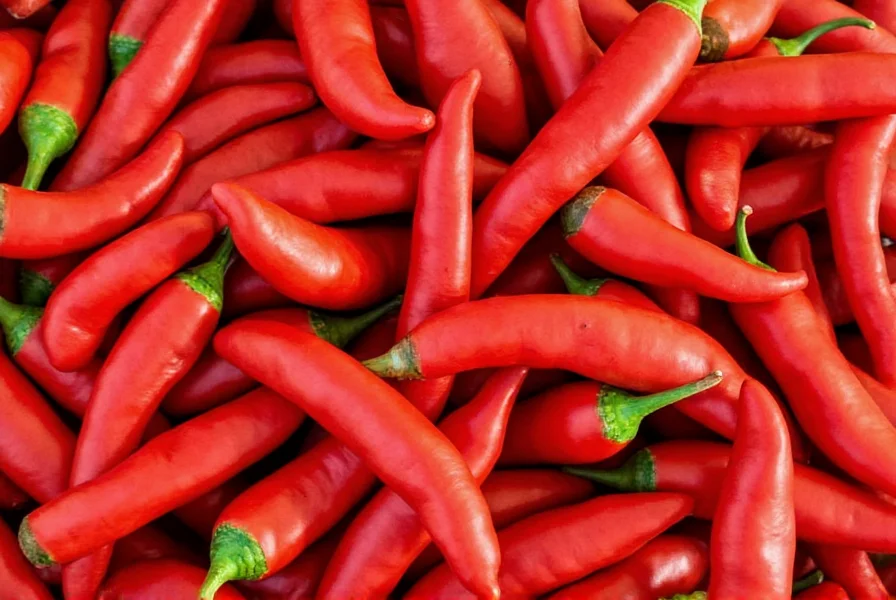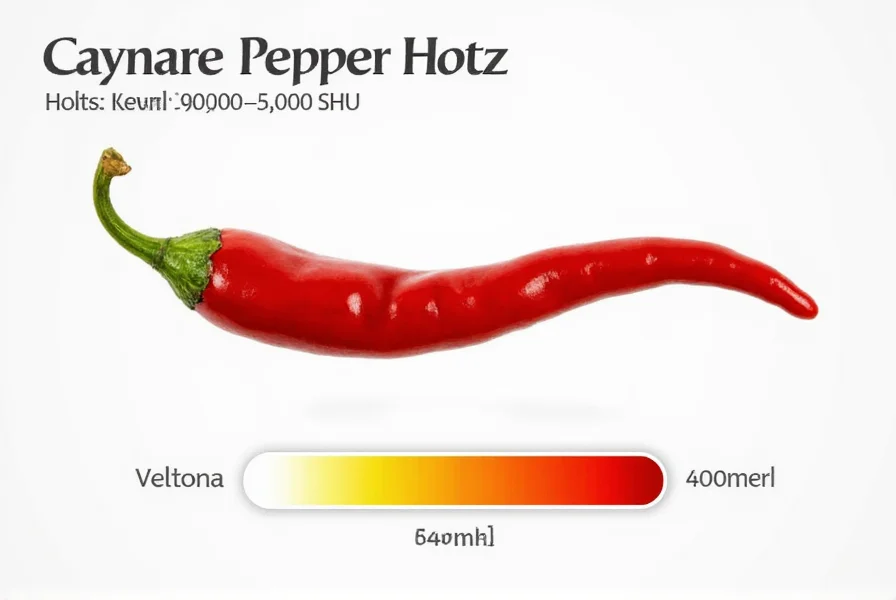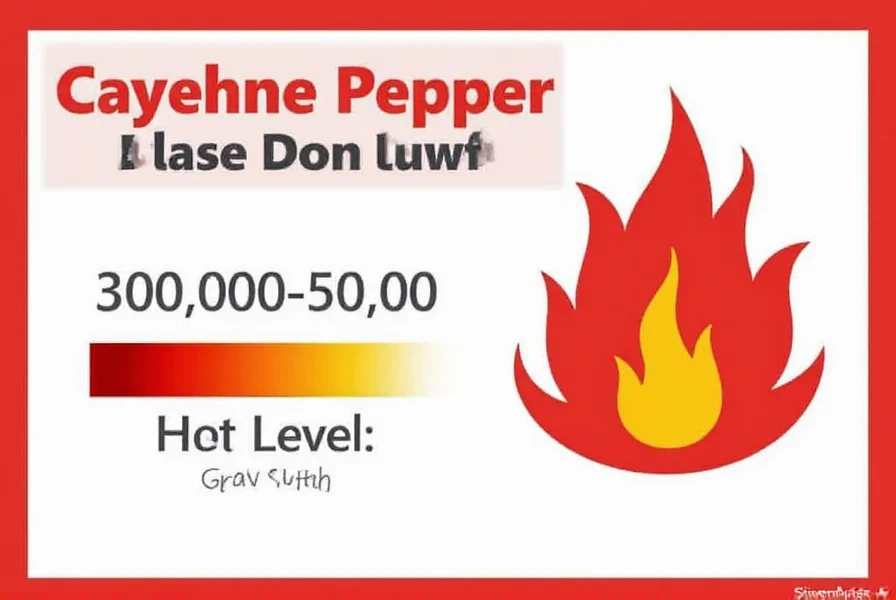Cayenne pepper's distinctive heat comes from capsaicin, the compound responsible for the burning sensation we associate with spicy foods. Understanding exactly how hot is cayenne pepper requires context within the Scoville scale, the standard measurement for chili pepper pungency. This measurement isn't arbitrary—it's scientifically determined through both laboratory testing and human sensory evaluation.
The Scoville scale, developed by pharmacist Wilbur Scoville in 1912, measures the concentration of capsaicinoids in chili peppers. Originally, the test involved diluting pepper extract in sugar water until the heat was no longer detectable by a panel of tasters. Today, high-performance liquid chromatography (HPLC) provides more precise measurements, though results are still converted to Scoville Heat Units for consumer understanding.
| Pepper Variety | Scoville Heat Units (SHU) | Heat Comparison |
|---|---|---|
| Bell Pepper | 0 SHU | No heat |
| Jalapeño | 2,500-8,000 SHU | 4-20x milder than cayenne |
| Cayenne | 30,000-50,000 SHU | Baseline for comparison |
| Habanero | 100,000-350,000 SHU | 2-11x hotter than cayenne |
| Ghost Pepper | 855,000-1,041,427 SHU | 17-34x hotter than cayenne |
When considering how hot is cayenne pepper compared to other common varieties, it's essential to recognize that heat levels can vary based on growing conditions, soil composition, climate, and specific cultivar. For example, cayenne grown in hotter, drier climates typically develops higher capsaicin concentrations than those cultivated in more temperate regions.
The heat profile of cayenne differs from other hot peppers in both intensity and duration. Unlike the immediate, sharp burn of a habanero that lingers on the tongue, cayenne delivers a more gradual, penetrating heat that spreads throughout the mouth and can last several minutes. This characteristic makes cayenne particularly valuable in cooking—it provides substantial heat without overwhelming other flavors.
For home cooks wondering how spicy is cayenne pepper in practical terms, consider that a single dried cayenne pod contains enough heat to noticeably spice an entire pot of chili. When using cayenne powder, most recipes call for just 1/8 to 1/4 teaspoon to achieve noticeable heat. The compound capsaicin is oil-soluble, which explains why dairy products like milk or yogurt effectively counteract the burn—casein proteins bind to capsaicin and help wash it away.

Understanding cayenne pepper heat level compared to jalapeno helps contextualize its position on the spice spectrum. A typical jalapeño ranges from 2,500 to 8,000 SHU, making cayenne approximately 4 to 20 times hotter. This means that substituting cayenne for jalapeño in a recipe requires careful measurement—using equal amounts would result in an unexpectedly fiery dish.
Safety considerations are important when handling cayenne. The concentrated capsaicin can cause skin irritation and severe eye discomfort. Chefs recommend wearing gloves when processing large quantities of cayenne peppers and avoiding contact with face or eyes. If accidental contact occurs, washing with soap and water followed by applying milk or yogurt can provide relief.
From a culinary perspective, cayenne's heat serves multiple purposes beyond mere spiciness. It enhances flavor perception, stimulates appetite, and can even preserve food through its antimicrobial properties. In traditional medicine systems worldwide, cayenne has been used for centuries to address digestive issues, improve circulation, and provide pain relief—effects directly related to its capsaicin content.
When evaluating what is the Scoville rating for cayenne pepper in commercial products, check for specific variety information. Some specialty cayenne cultivars like the 'Long Slim' or 'Gold Thread' may fall at the higher end of the spectrum, while others might be milder. Processed cayenne products like sauces or powders often blend cayenne with other ingredients, which can significantly alter the perceived heat level.
For those exploring is cayenne pepper hotter than habanero, the answer is clearly no. Habaneros start where cayenne ends, beginning at around 100,000 SHU—more than double the maximum cayenne heat. This substantial difference explains why habanero-based hot sauces require caution, while cayenne can be used more liberally in everyday cooking.

Understanding the precise heat measurement of cayenne helps cooks make informed decisions in the kitchen. Whether you're building flavor complexity in a curry, adding depth to a barbecue rub, or creating a warming winter soup, knowing how hot is cayenne pepper in Scoville units allows for precise heat control. The versatility of cayenne—delivering substantial heat without completely dominating other flavors—makes it a staple in spice cabinets worldwide.
How does cayenne pepper heat compare to black pepper?
Cayenne pepper is significantly hotter than black pepper. While cayenne measures 30,000-50,000 Scoville Heat Units, black pepper registers only 10-100 SHU. This means cayenne is approximately 300-5,000 times hotter than black pepper, explaining why they're used in vastly different quantities in cooking.
Can cayenne pepper cause health problems?
While generally safe in culinary amounts, excessive cayenne consumption can cause gastrointestinal distress including heartburn, stomach pain, and diarrhea. People with ulcers, GERD, or sensitive digestive systems should use cayenne cautiously. The capsaicin in cayenne can also irritate skin and eyes, so handling precautions are recommended when working with fresh peppers or concentrated powders.
Why does milk help with cayenne's burning sensation?
Milk helps alleviate cayenne's burn because it contains casein, a protein that binds to capsaicin (the compound responsible for heat in cayenne) and helps wash it away from nerve receptors. Since capsaicin is fat-soluble, the fat content in whole milk makes it more effective than skim milk. Other dairy products like yogurt and sour cream work similarly, which is why they're commonly used in spicy dishes from various cuisines.
Does cooking affect cayenne pepper's heat level?
Cooking doesn't significantly reduce cayenne pepper's heat level. Capsaicin is stable at cooking temperatures, meaning the Scoville rating remains relatively constant whether cayenne is used raw or cooked. However, prolonged cooking can distribute the heat more evenly throughout a dish, and certain ingredients (like dairy or sugar) can counteract the perception of heat, making the dish seem milder even though the actual capsaicin content hasn't changed.
How can I reduce the heat of a dish that's too spicy with cayenne?
To reduce excessive cayenne heat in a dish, add dairy products (milk, yogurt, or sour cream), acidic components (lemon juice or vinegar), or sweeteners (sugar or honey). Increasing the overall volume of the dish by adding more non-spicy ingredients can also dilute the heat. Starchy foods like rice or bread can help absorb some of the capsaicin. Remember that water won't help—it can actually spread the capsaicin oil, making the burning sensation worse.











 浙公网安备
33010002000092号
浙公网安备
33010002000092号 浙B2-20120091-4
浙B2-20120091-4